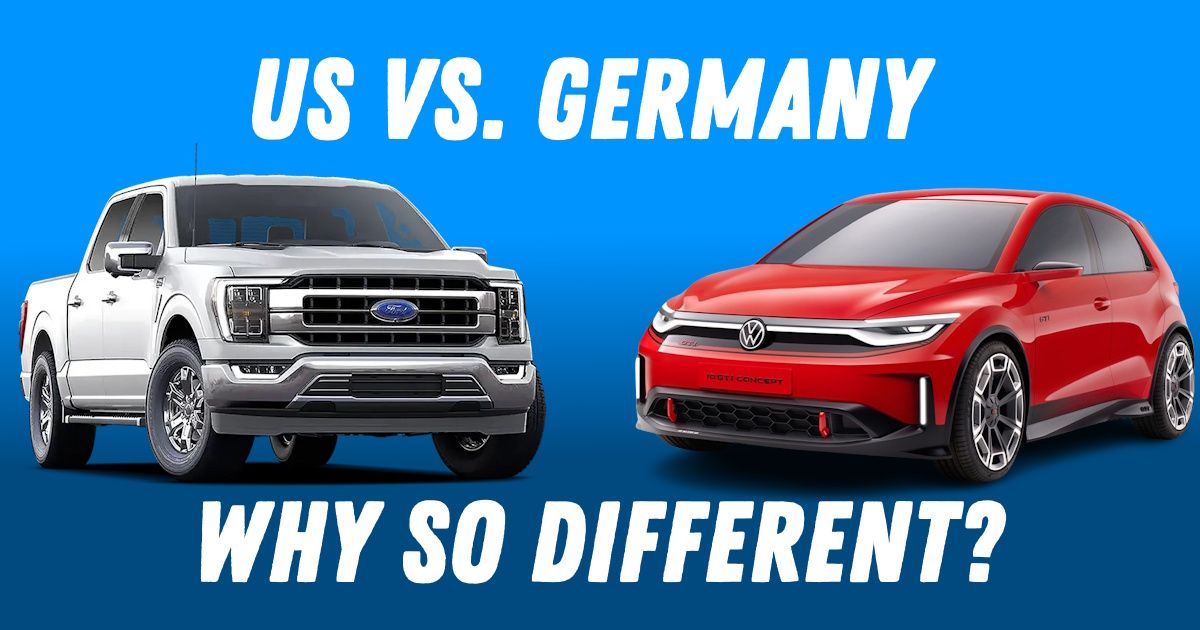Why Do American and German Cars Look So Different?


If you’ve ever looked at a towering Ford F-150 and then at a sleek Volkswagen Golf and felt like they belong to two different species, you’re not wrong. They do. Though both are machines built to carry people across distances, they’re shaped by different histories, geographies, and ideologies. The result is a dramatic visual split—American cars are big, brash, and unapologetically bold, while German cars are restrained, refined, and precision-focused. But the real question is: why?
In America, cars aren’t just about transportation—they’re about identity. The automobile is a cultural symbol, a rolling manifestation of freedom, ambition, and independence. It's the spirit of the open road, baked into metal and chrome.
And because the American landscape is vast and open, the cars reflect that scale. Post-WWII infrastructure—like the expansive interstate system—was built for long, straight roads with few constraints. There's space to park, drive, and roam. The result? Cars that are large in every sense of the word: wide shoulders, upright cabins, massive grilles, and flat hoods that seem to stretch toward the horizon.
Design cues scream capability and dominance. Pickup trucks and SUVs with towering front ends suggest power, even when they’re more likely to haul groceries than gravel. A Ram 1500 or a Chevy Suburban isn’t just a utility vehicle—it’s a statement. Even sedans like the Dodge Charger carry an assertive stance, muscular lines, and a size-first attitude that favours presence over subtlety.
Inside, the story continues. American cars often feature broad, cushy seats, deep cupholders, and tech-laden dashboards that prioritise ease and comfort. The design goal is clear: comfort on long drives, even if most owners rarely leave the city.
Across the Atlantic, the German approach to car design couldn’t be more different. The car here isn’t an extension of personality—it’s an engineered tool. Sleek, compact, and obsessively balanced, the average German car is the result of a philosophy where function refines form.
Germany’s roads—and the cities they wind through—are tighter, older, and more demanding. You’re just as likely to be navigating a narrow cobblestone street in Cologne as flying down an unrestricted stretch of the Autobahn. That duality demands a different kind of car: one that’s agile, efficient, and designed with millimetric discipline.
German cars, even sporty ones, often favour minimalism. The styling is deliberate but never flamboyant—clean lines, low profiles, tight panel gaps, and proportions that are more balanced than brutish. A BMW or Audi might turn heads, but it does so with an air of calculated restraint. There’s no flexing here—just form that quietly follows function.
Even a humble Volkswagen Golf is an exercise in balance. It’s compact enough for urban driving, aerodynamic for fuel efficiency, yet engineered to hold its own at high speeds on the Autobahn. That pursuit of harmony—between performance, efficiency, and elegance—shapes the entire look and feel of the vehicle.
The design split between American and German cars is no accident. It’s the outcome of deeper systemic forces that shape what cars need to do, and how they’re expected to look while doing it.
America was built around the car—literally. Wide roads, long distances, suburban sprawl, and vast parking lots allow vehicles to grow larger without consequence. In contrast, Germany’s cities were centuries old before the car arrived. Roads twist around rivers, hills, and old town walls. In such spaces, size becomes a liability—and design has to work within tighter constraints.
In the U.S., vehicle safety regulations focus heavily on protecting occupants. This allows designers to create tall front ends and bluff grilles—hallmarks of the American look. In Germany (and Europe more broadly), regulations prioritise pedestrian safety. That means lower, more sloped hoods, softer nose lines, and slimmer profiles—all of which push designers toward sleeker, more streamlined shapes.
American car buyers don’t pay extra for larger engines or higher emissions. Fuel is relatively cheap. That gives designers and consumers more freedom to embrace size. In Germany, taxes based on engine displacement and CO₂ output push carmakers toward efficiency—both in performance and packaging. That’s why even performance cars in Germany tend to be turbocharged and modestly sized.
At heart, American cars are about possibility—the freedom to go anywhere. German cars are about the mastery—the pleasure of getting there well. This core difference permeates design decisions—resulting in cars that either celebrate comfort and scale, or chase the perfect balance of form and function.
Even the way we drive influences what our cars look like. Americans often drive long distances in straight lines, valuing comfort and convenience over cornering finesse. That’s why the design language embraces broad surfaces, large footprints, and an almost architectural heft. In contrast, German cars are designed for more varied, curvy roads—demanding precision from both driver and machine. Hence, their lines are more sculpted, more athletic, and their silhouettes more disciplined.
The very road becomes an invisible designer—shaping not just how a car moves, but how it looks standing still.
Yes, there’s overlap today. American brands are borrowing from German playbooks—focusing more on interior quality, precision, and compact crossovers. German brands, meanwhile, have embraced the global SUV trend, rolling out larger, softer-riding models for American buyers.
But the foundational philosophies still stand. One side builds cars for the open horizon; the other for mastering the next curve. One celebrates scale; the other celebrates synthesis.
So, the next time you find yourself admiring a Dodge Challenger or a Porsche Taycan, look beyond the badge. You’re seeing the product of landscapes, laws, and lifestyles. Two worlds on four wheels—each built not just to move, but to express something deeper about the people who drive them.